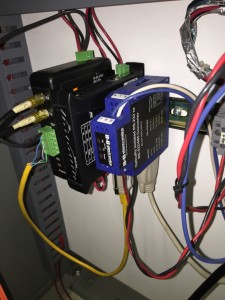Jim Mimlitz, NRI
In rural areas — due to a combination of long power transmission line lengths and the relative isolation of the remote pumping facilities — it is not uncommon for stations to suffer from power quality problems. Therefore, it is always recommended that a station’s power status be monitored, trended, and alarmed for outages.
In the most basic sense, monitoring the digital (ON/OFF) power status through use of a 3-phase monitor is recommended. However, knowing the analog status (voltage level) would deliver a more detailed picture.
In order to collect detailed power telemetry information, sophisticated telemetry devices are commercially available for monitoring voltage, power, current, power factor, etc. An excellent, Modbus-capable device that NRI has used successfully in the past is the Model Shark 100 by Electro Industries/GaugeTech.
However, if you are looking for a more basic and economical method of monitoring the electric utility’s 3-phase voltage level, then an excellent alternative is to request it from a pump station’s VFD.
How is this possible?
In this past year, NRI introduced a new firmware library — “VFD & Energy Analytics for Telemetry, SCADA, and Control Systems” — which empowers an RTU with the capability to extract a variety of useful information from a VFD through a network. In this case, we leverage the faculties of this library to request the VFD’s DC bus voltage. We know that the DC bus voltage is derived from a full-wave-rectification of the incoming 3-phase power, and therefore…
Utility Voltage ≅ DC Bus Voltage / √2
≅ DC Bus Voltage / 1.4142
For example, if the DC Bus Voltage is read from the VFD as 685 VDC, then we know — based on both theory and actual measurements — that the incoming utility voltage (average 3-Phase RMS) is approximately 484 VAC.
Recently, we had the opportunity to retrofit such voltage-monitoring capability at two rural water district pumping stations. Both stations had been experiencing voltage-related problems; and this upgrade was designed to alert the operators whenever the incoming voltage was outside acceptable tolerances. Each station was already equipped with a Modbus/RTU network for collecting data from various smart devices, including EtherMeters, pressure transducers, and a tank mixing system. The station was also equipped with VFD-driven pumps. The Modbus/RTU network was expanded to collect an approximation of the utility’s average 3-phase voltage from the VFDs: (VAB+VBC+VAC)/3

24 Hour History Chart. Note that the Voltage Levels are erratic and reaching higher-than-acceptable levels, especially 11PM-6AM, which was the main reason that the Water District requested this capability. History trending charts such as these can be useful tools for documenting voltage problems — and for conveying the problems to the local electric utility.
Are you interested in implementing this type of basic, economical 3-Phase Voltage Monitoring capability at one or more of your stations?
This feature — and many more — are now available as part of our new VFD & Energy Analytics Package for Telemetry, SCADA, and Control Systems.
Give us a call, and we’ll be glad to discuss this with you in further detail.
Telemetry, SCADA, & Controls Newsletter
Was this article helpful? Would you be interested in receiving updates such as these in our occasional email-delivered newsletter? If so, here’s our sign-up page:
Subscribe to Navionics Research’s “Telemetry, SCADA, & Controls Newsletter”







